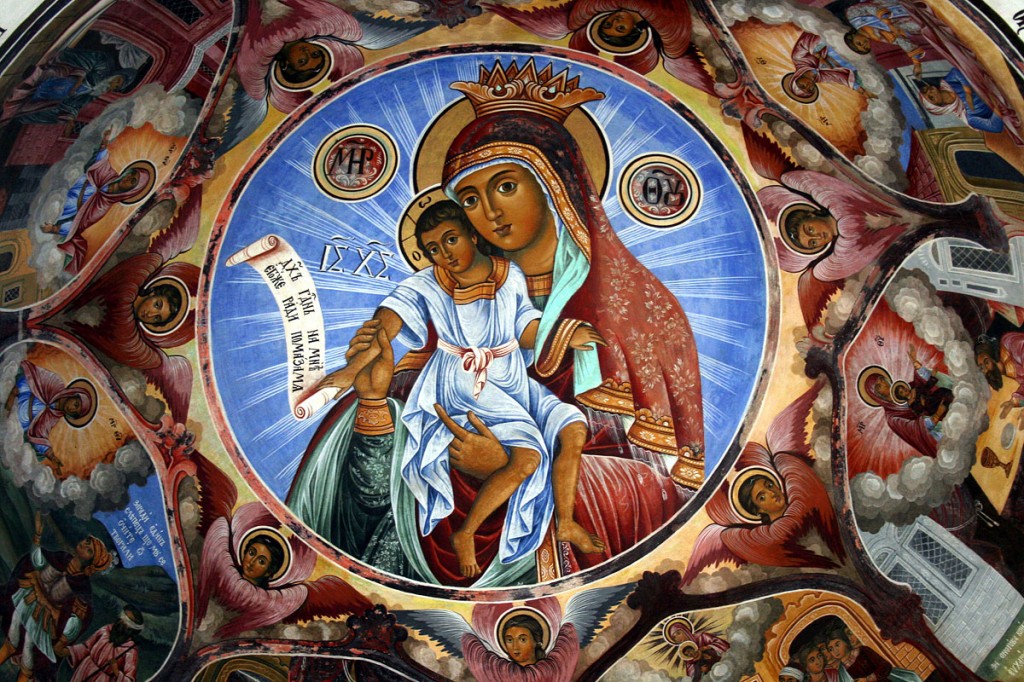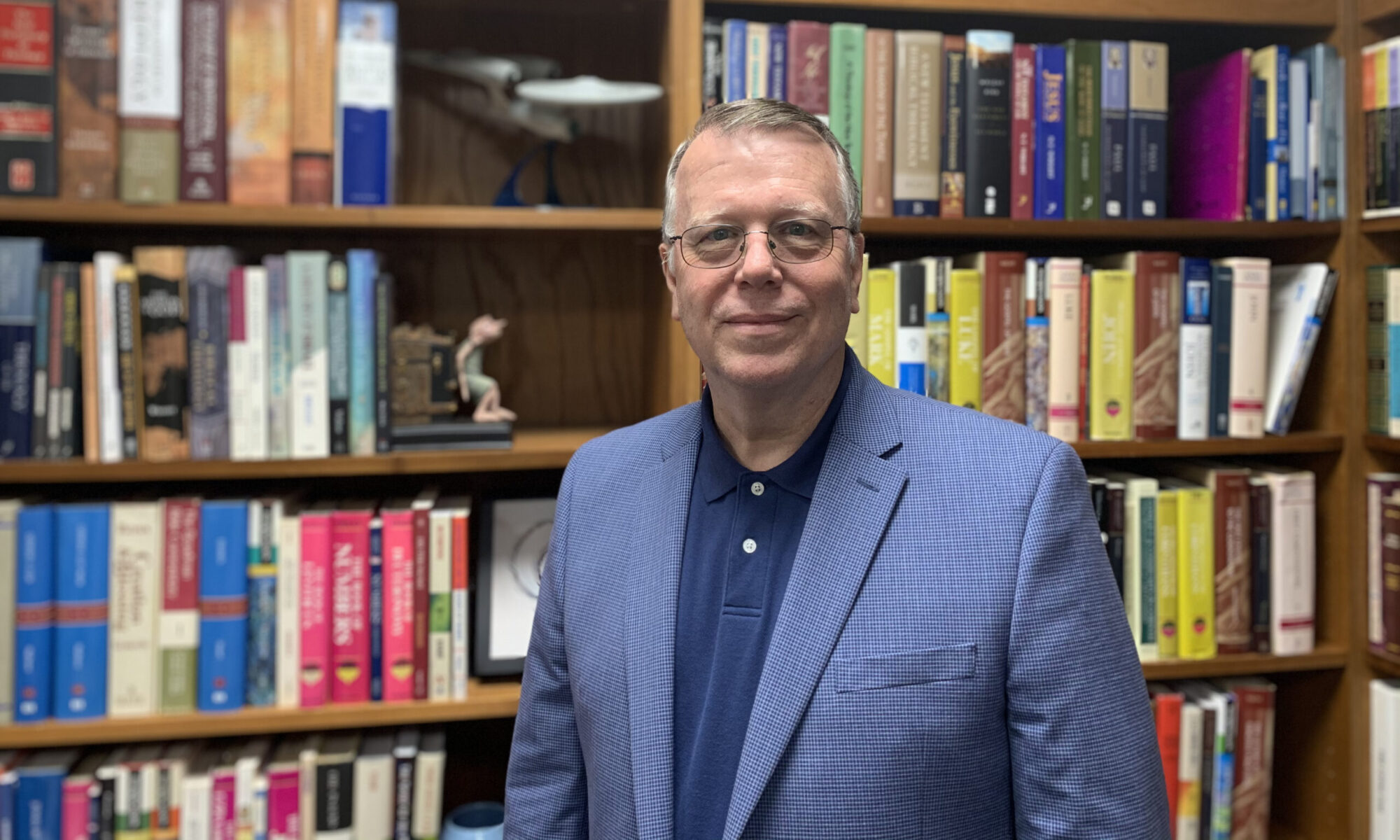…the angel Gabriel was sent from God to a city in Galilee called Nazareth, to a virgin… and the virgin’s name was Mary. And coming in, he said to her, “Greetings, favored one! The Lord is with you… Do not be afraid, Mary; for you have found favor with God. And behold, you will conceive in your womb and bear a son, and you shall name Him Jesus.He will be great and will be called the Son of the Most High… and His kingdom will have no end.” Mary said to the angel, “How can this be, since I am a virgin?” The angel answered and said to her, “The Holy Spirit will come upon you, and the power of the Most High will overshadow you; and for that reason the holy Child shall be called the Son of God” (Luke 1:26-35).
Several years ago (1999), during my first trip to Bulgaria, I visited the Rila Monastery. The monastery is settled in the midst of the beautiful forests near Rila Mountain. I was overwhelmed by the iconic art that covered the buildings. I quickly noticed that the great majority of the art represented the Virgin and Child.

Coming from the context of Western/Protestant Christianity, I found it strange that there were few depictions of the crucified Christ, or the resurrected Christ. In the gift shop of the monastery I wanted to buy two souvenir icons, one of the Virgin and Child and one of Christ resurrected. Although there were dozens depicting the Virgin, I could find none that depicted Christ on the cross or resurrected. Later, the next day I toured the Alexander Nevsky Cathedral in Sofia. Again, there were many iconic depictions of the Virgin and Child. In Cathedral gift shop I again searched for a souvenir icon of the Resurrected Christ and after some time, I found one in the midst of scores of the Virgin. Happy with my find, I continued my journey. About a week later I was back in my office placing my two souvenir icons on the wall.
Over the next few weeks, I reflected about the two iconic representations. I often wondered, “Why is the Virgin so important to Orthodox (and Catholic) believers?” Then one day I had an epiphany. Whereas, for Western Christians the faith focused on the passion and resurrection of Jesus; Eastern Christians have focused on the Incarnation. It isn’t Mary that is the focus of Orthodox worship, it is the child – the incarnate Christ. In the past few years I have devoted much time to reading and reflecting about Orthodox Christology and I have found it to be compelling. In the Western tradition we tend to focus on the events in the life of Jesus – birth, ministry, passion, resurrection, ascension, and return. In the Eastern tradition, the focus is on the Christ event – the whole incarnational narrative. The veneration of Mary in the Catholic and Orthodox traditions is an expression of Nicene Christology.
We believe in one Lord, Jesus Christ, the only Son of God, eternally begotten of the Father, God from God, light from light, true God from true God, begotten, not made, of one Being with the Father; through him all things were made. For us and for our salvation he came down from heaven, was incarnate of the Holy Spirit and the Virgin Mary, and became truly human.
During the first centuries of the church the greatest theological controversy sought to answer the question, “How is Jesus of Nazareth God?” A full discussion of the Christological developments can fill a library with books. I want to briefly address only one issue – the significance of Theotokos, which says that Mary is “God-bearer.” I remember this discussion in my theology class in seminary. Our professor insisted that Theotokos was improper and it is better to think of Mary as “mother of our Lord.” I must challenge that statement and affirm Mary as Theotokos. Why?
During the Christological debates of the 3rd and 4th centuries the many controversies can be expressed in two words – Theotokos or Christotokos. Is Mary the mother of the Christ, or is Mary the mother of God? If Mary is Christotokos, the mother of the Christ, then when did Jesus become Christ? Maybe, Jesus was not God incarnate, but was later adopted or anointed as the son of God. If so, then Jesus is not of the same divine essence of the Father. To suggest that Mary is “mother of our Lord” falls into the same theological trap – that Jesus may not be the eternal Son. Christotokos cannot fully express the meaning of Jesus Christ. Mary is Theotokos – the mother of God. Theotokos affirms the full divinity of Christ, that Jesus, the son of Mary, is of the same essence with the Father and Holy Spirit; that Jesus Christ is the union of eternal divinity and humanity. The union of God and human took place in the womb of the Virgin.
So, allow me to offer a few reflections on the significance of Mary, the mother of God, from the context of Protestant and Pentecostal faith. From the Protestant tradition, I have many reservations about how the veneration of Mary is expressed in Catholic and Orthodox spirituality. The doctrine of the Immaculate Conception of Mary explains how Jesus could be born of a fallen human mother and still be unaffected by human sin. This doctrine teaches that Mary was conceived without sin; therefore the divine Child was never touch by human corruption. And, although there is a theological distinction between worship offered to God and veneration offered to Mary, I’m afraid that distinction is often lost in practice. Once, as I was watching EWTN, I listened to some Charismatic Catholics testify to being Spirit-baptized. One of the sisters said, “It was like I stepped into Mary.” It seems that some Catholics have confused Mary with the Holy Spirit.
I once had a discussion with a Pentecostal theologian who was lamenting the limited role imposed upon women in the church. He said, “The restricted role of women in the church is embarrassing.” I replied, “That’s only true as it relates to Protestant Christianity.”* I then reminded him of the prominent role of Mary and the many female saints in Catholic spirituality. As Pentecostals continue to struggle with role of women in the church, I suggest that the discussion should begin with Mary as Theotokos. That Jesus is fully human, and that his divine humanity is derived from conception in the womb of the Virgin Mary, suggests that male and female are of the same human essence, are baptized in the same Holy Spirit, and are therefore consubstantial. To suggest that females are ontologically subordinate to males in any way is inconsistent with the role of Mary as Theotokos and suggests that female believers’ Spirit baptism is in some manner less than that of male believers. All believers, male and female, are in Christ. In Christ there is no distinction between male and female (Galatians 3:27-28). Male and female believers are equally and substantially Spirit-filled. That means both male and female believers are equally gifted for ministry and service to Christ and His Church.
As a Pentecostal, I suggest that the descent of the Spirit upon the Virgin Mary should be understood as the first fruit of Joel’s prophecy: “I will pour out my Spirit upon all flesh” (Joel 2:28). Just as male and female participated in the fall, so too does male and female participate in the redemption of humanity. Mary’s unqualified obedience to God is presented as an answer to Eve’s disobedience. As the Spirit of God came upon Mary and effected the conception of Jesus, the Spirit also effected Mary’s sanctification. God the Son was united to humanity through the flesh of Mary. The Christ Child was unaffected by human corruption because Mary was sanctified, or perfected, by the Holy Spirit. Here I will allow that Mary was sanctified in a manner that is unique to humanity (This speaks more to my understanding of sanctification than Marian devotion). Although I confess that salvation is through Christ alone, I must affirm the unique role of Mary in human redemption. The divine-human child of Mary is the one who baptizes in the Spirit and fire (Luke 3:16).
While I cannot venerate Mary, I will honor her. As I honor Mary, I will also honor my sisters in the church by recognizing their Spirit given gifts.
*I am aware of the Catholic limitations of women in the priesthood. But the Catholic veneration of Mary, the canonization of female saints, and the inclusion of females as doctors implies a sensitivity that is not shared in many Protestant churches.
Originally posted on December 16, 2011.
